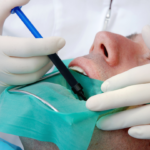
What Causes a Root Canal?
August 31, 2023
Apicoectomy vs. Root Canal: What is the Difference?
September 25, 2023
What Causes a Root Canal?
August 31, 2023
Apicoectomy vs. Root Canal: What is the Difference?
September 25, 2023You may not think about the parts inside your teeth, but luckily your endodontist does. The primary concerns with endodontics include understanding and treating dental pulp. Find out more about the pulp and why it needs endodontic treatment if something happens to it.
Parts of the Tooth
To understand the pulp, you need to know about its placement and role among the other parts of your teeth. Each of your teeth contains three layers. The outermost layer, the enamel, consists of the hardest material in the human body. Enamel is even tougher than bone.
Underneath the enamel lies the dentin. Like the enamel, the dentin also helps to protect the softer pulp inside. Dentin depends on the pulp for its nutrients and development.
Below the gumline, each tooth has an outer layer called the cementum. This part of the tooth offers additional protection for the roots.
Finally, at the core of the tooth lies the gelatinous pulp. This part of the tooth may be the most important due to its multiple functions.
What Is Dental Pulp?
The dental pulp includes all the cells needed to build up the dentin and nourish it. Several types of specialized cells help dentin development, dentin nourishment, and immune function. Plus, the pulp contains blood vessels and nerves. In fact, the pulp is the only living part of the tooth, which explains why it requires an active blood supply.
The blood vessels and nerves that supply the pulp pass through the tiny root end openings at the bases of the teeth. Then these vital components move up the radicular (root) canals to the main pulp chamber inside the crown. At the top of the main chamber, tiny pulp horns reach up to the biting surface to extend the reach of the pulp’s services to the dentin.
The components inside the pulp help it to perform its functions for the health of your entire tooth.
Why Do You Need Dental Pulp?
Dental pulp serves four main purposes for the tooth. These tasks help the tooth avoid infection and damage by protecting the tooth and alerting you to damage.
Forms the Dentin
The dentin protects the pulp, and the pulp has a reciprocal action in forming the dentin. Dentin formation ensures that the tooth has a barrier between the outside and the pulp in case the enamel experiences wear.
Nutritionally Supports the Dentin
To maintain the dentin layer, the pulp produces fibrinogen and albumin, which are proteins for the dentin. These proteins keep the dentin healthy and intact, which mitigates daily wear on the teeth. Tiny tubules inside the dentin carry these nutrients from the pulp to the dentin.
Fights Bacteria
The pulp has immune cells to combat bacterial invasions if the enamel and dentin fail. These immune cells cause inflammation and swelling as they attempt to neutralize the bacteria inside the tooth.
Alerts You of Tooth Problems
The pulp also contains the nerves for your tooth. If you feel extra sensitivity to hot and cold or biting pressure, you may have a problem with your tooth. The nerves in the dental pulp can feel discomfort and let you know that you have a dental problem.
What Can Go Wrong with the Pulp Inside Teeth?
Typically, the pulp will continue to function as a source of nutrition for the dentin unless something breaches the enamel and the dentin then reaching the pulp. Typically, this damage happens from decay, but it can also occur from a crack or break in a tooth.
Once exposed to bacteria from the outside, the pulp becomes at risk for bacterial infection. The immune cells in the pulp will try to protect the rest of the tooth by attacking bacteria. When they attack, they’ll cause inflammation and swelling, known as pulpitis, which puts pressure on the tooth’s nerve. You’ll notice discomfort and swelling around the tooth or extra sensitivity to pressure or temperature.
Don’t ignore this discomfort. If you do, it can worsen to severely damage the pulp and cause pulp death, called pulp necrosis. Once this happens, your discomfort will suddenly go away. But that is not a good sign. It means that the tooth pulp has died, which may allow the bacteria inside the pulp to spread to other parts of your mouth or the rest of your body.
Getting early treatment can help you save your tooth and avoid a systemic infection or dental abscess. Endodontists focus their care on treating the pulp and saving teeth and can help you to avoid losing part of your smile.
Signs You May Have a Problem with Your Dental Pulp
Watch out for some of the following signs that you may need endodontic care to address a pulp problem:
- Prolonged sensitivity to temperature
- Extra sensitivity or discomfort when eating sweets or biting down
- Swelling at the gums at the base of a tooth
- Localized gum redness
- Fever, bad breath, pus, and swollen lymph nodes in the neck in severe infections
Contact your local endodontist to set up an evaluation as soon as possible. The doctor can then decide on the type of treatment that can remove the infection from your tooth and protect it from future harm or loss.
How an Endodontist Treats Infected Pulp
Endodontists typically opt for non-surgical root canal therapy to remove infectious materials from the inside of the tooth.
During a root canal, the endodontist accesses the pulp chamber through the tooth and clears out the tooth. This includes removing the pulp, and bacteria from the tooth. The endodontist seals the chamber and adds a filling to protect the tooth from harm later. You may need a crown over the tooth if you had a molar treated.
Root canal therapy eases any discomfort and ensures you retain a functioning tooth. The procedure is painless, and healing takes only a few days.
If you have pulp issues, go to an expert in treating dental pulp, an endodontist, to assess your tooth and give you the care you need.
Need an Endodontist Near Charleston? Trust Us at Innovative Endodontics
When you have pulp problems, trust the experts in treating this part of the tooth. Call us at Innovative Endodontics to schedule a visit. We work hard to change the reputation of root canals in the Charleston area. Let us help you realize that endodontic treatment offers a way to address pulp issues painlessly.




